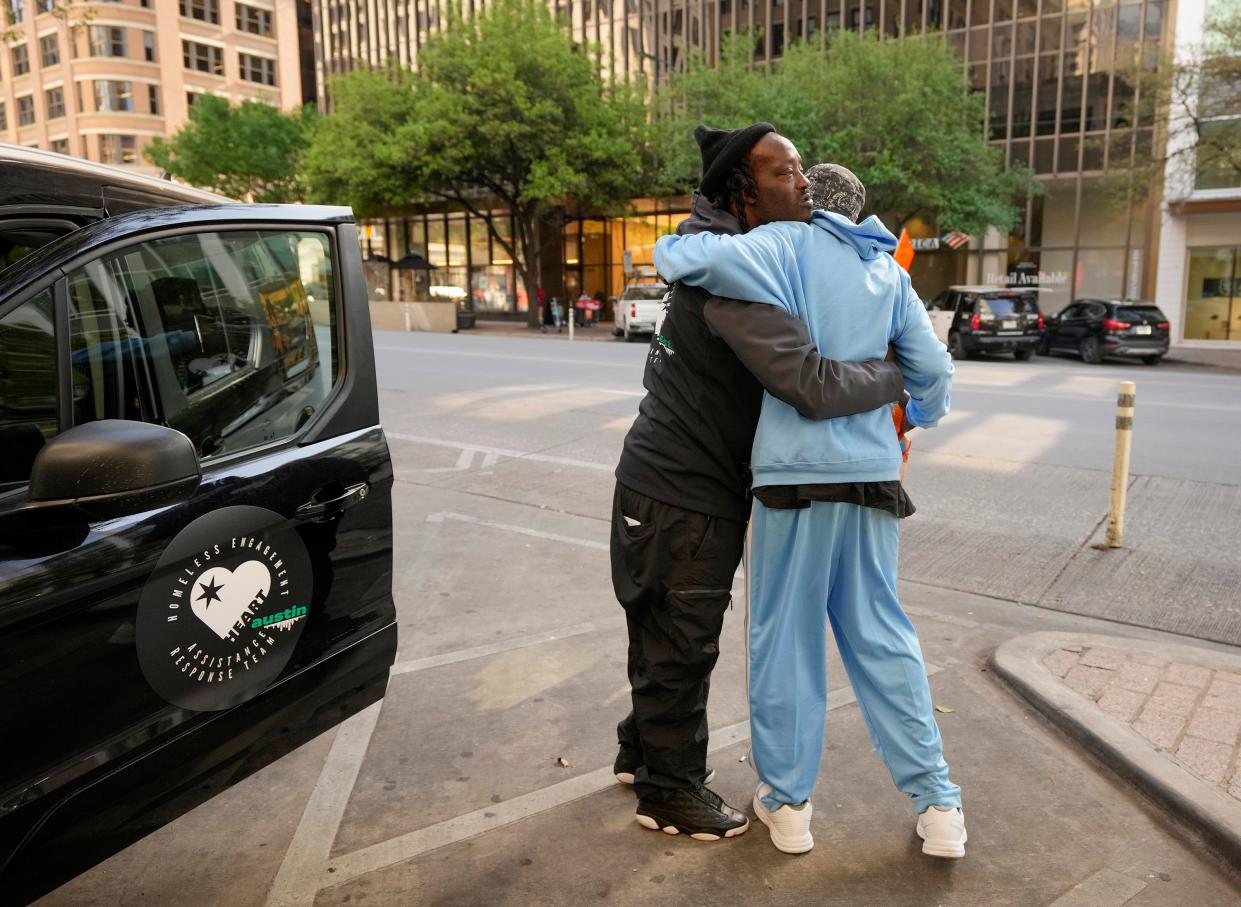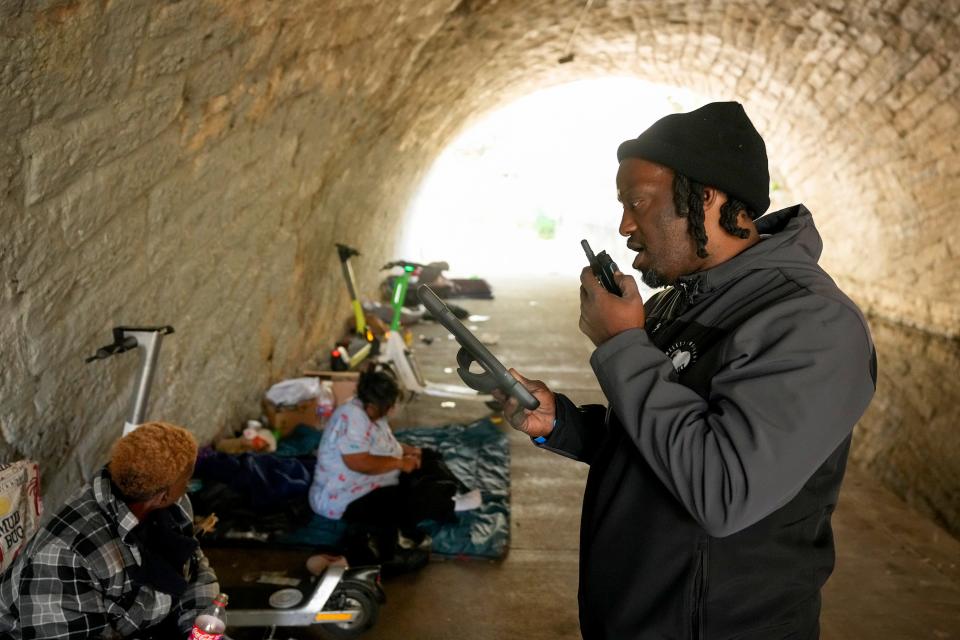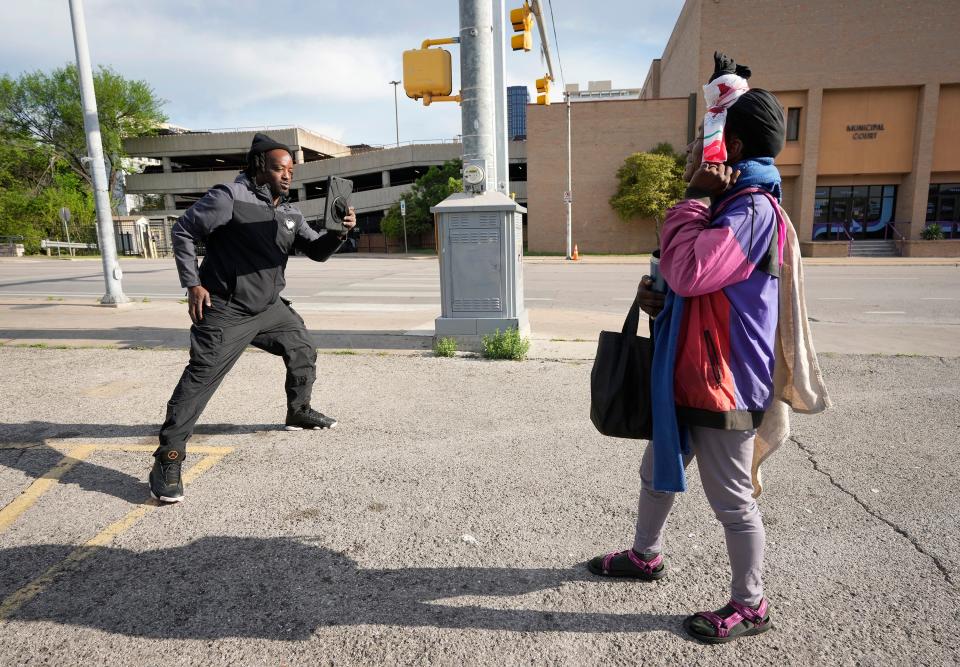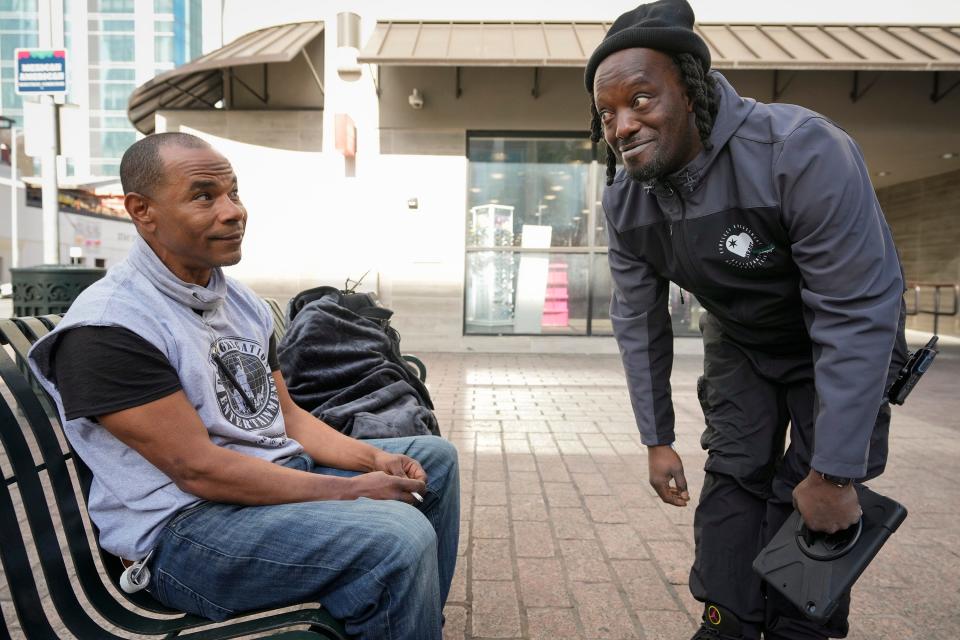Austin pilot program aims to serve the homeless without involving police. Is it working?

Shelley Davis, who goes by “L.D.,” spends his days driving around downtown Austin, checking on people experiencing homelessness. He greets them casually — “Hey, mamma, you all right?” — and carries around a pack of Newport cigarettes and, occasionally, lunches from Wendy’s.
Davis doles them out with an impartial friendliness while asking some pointed questions: Do you have a case manager? Do you want to go into a shelter? Have you completed a housing assessment?
Davis is part of the Homeless Engagement Assistance Response Team, or HEART, a pilot program that conducts homeless outreach and responds to nonemergency calls in a portion of downtown Austin. The program, which started in February and is slated to run through the end of July, is funded by the Downtown Austin Alliance and staffed by Urban Alchemy.
The HEART team, consisting of two outreach workers and a dispatcher, responds to calls made by the alliance's “ambassadors” and overtime police officers. Team members may be asked to talk to someone who is agitated or connect someone to homeless services. When not responding to calls, the HEART team patrols the service area — which stretches for a few blocks between Congress Avenue and the Interstate 35 service road — and gets to know people experiencing homelessness there.
Urban Alchemy has similar outreach programs in Los Angeles and San Francisco. Kirkpatrick Tyler, who directs community and government affairs at Urban Alchemy, described HEART as a “community-based public safety response” and an “alternative to policing.”
“Instead of calling law enforcement, you send equipped and trained practitioners with resources and support, who have spent the time and made the investments to build relationships, so that they can engage with our unhoused neighbors,” Tyler told the American-Statesman.
HEART is an expansion of Urban Alchemy's homeless services in Austin, which include an outreach team; the Austin Resource Center for the Homeless, a men's shelter; and the Eighth Street Shelter, which serves women and transgender people. Urban Alchemy first arrived in Austin to perform outreach in 2022. The organization's history came under scrutiny later that year, when the City Council considered contracting it to operate the ARCH. At the time, city officials expressed concerns about lawsuits and complaints accusing Urban Alchemy workers of drug distribution and sexual assault in California.
In a statement, Urban Alchemy Chief Operations Officer Bayron Wilson defended the organization's work and said that it takes all claims of misconduct seriously. Wilson told the Statesman that Urban Alchemy has received "so much positive feedback" from residents and business owners in downtown Austin. Bill Brice, senior vice president of the Downtown Austin Alliance, said it made "all the sense in the world" to partner with Urban Alchemy for HEART, given that the organization runs the two downtown shelters.
In the first two months of the HEART pilot, outcomes have been modest — of 394 reported interactions with people experiencing homelessness, 25 people entered a shelter and 10 completed housing assessments. The Downtown Austin Alliance and Urban Alchemy stress that building trust takes time, but in the meantime, HEART members face the challenge of balancing enforcement with providing social services.

'Multiple touches' required
Familiarity is a valuable commodity in homeless outreach, and it comes easily to Davis, who grew up in Austin and around some of the people he works with today.
One morning in March, Davis waved down Natalie Campbell, 40, as she walked down East Seventh Street in a colorful jacket. Campbell, who told the Statesman she was experiencing homelessness, greeted Davis warmly. She had known him for a while and said he was "easy to talk to."
She gave Davis some personal information and posed for a photo, which he logged into an internal Urban Alchemy database.

Many of Urban Alchemy's employees spent time in prison, some decades. Kevin Lee, Urban Alchemy’s director of operations in Austin, told the Statesman that he spent 31 years in prison. People who were incarcerated can relate to people experiencing homelessness, Lee said.
“You've been in those shoes before. You know something about the feeling of being discarded from society,” he said. “But you have the tools in order to help that individual because somebody helped you.”
In addition to the 394 interactions in the first two months of HEART, the team had 304 food distributions. A small portion of people exited unsheltered homelessness through HEART — along with the 25 people who went into a shelter, six were reunified with family. Brice, who coordinates the Downtown Austin Alliance's homelessness initiatives, said that he was "encouraged" by the data. Helping someone leave homelessness is a complicated process that requires trust, Brice told the Statesman.
“A person's willingness to accept help often takes time and multiple touches, “ Brice said.
Enforcement or help?
There is an element of enforcement to HEART's "community-based public safety response," as Tyler, the Urban Alchemy director, put it. Team members might have to mediate between downtown business owners and people experiencing homelessness, and that can involve asking someone to leave a particular location.
Tina Smith, who analyzes data at Urban Alchemy and occasionally goes out with HEART, said the team tries to prevent people from "settling down" where they are impeding business. When business owners feel that someone is being disruptive, HEART members may step in, offering food or diverting the person to services. The team tries to prevent a situation from escalating to the level of law enforcement, acting as a “buffer” between homeless people and police, Smith said.
But the point of HEART isn’t to tell people to “go be homeless somewhere else,” Brice told the Statesman. For a while, the HEART team referred people to the "Oasis," a parking lot behind the Eighth Street Shelter where Urban Alchemy had set up tents and seating. As of Friday, the "Oasis" was closed for construction, with plans to open bathrooms.
Louie Hammonds, Urban Alchemy's director of community-based public safety, said it’s possible to balance enforcement and services.

Hammonds compared a relationship with a person experiencing homelessness to a bank account. Building relationships, Hammond said, requires “deposits,” such as handing out a hot lunch. When it comes time to ask something of the person experiencing homelessness — like moving out of a business’s doorway — an outreach worker “withdraws” from that preexisting relationship.
Homeless outreach is rarely straightforward, especially when substance use or mental illness is an issue.
One morning in March, Hammonds joined Davis on a HEART patrol. While they were on Congress Avenue, a man passed by, knocking down electric scooters as he went. Hammonds and Davis followed him down the street, staying a few hundred yards behind. Farther behind Hammonds and Davis were some security guards.
When the man veered off Congress and into a parking lot, Hammonds and Davis came to a stop. They decided not to pursue him any further.
“If we had confronted him … we’d be escalating (the situation),” Hammonds said.
Hammonds and Davis turned around on Congress and picked up each knocked-down scooter.
The next day, Davis again saw that man, who told Davis he had been having a bad day.
This article originally appeared on Austin American-Statesman: Austin program aims to serve homeless without police involvement

